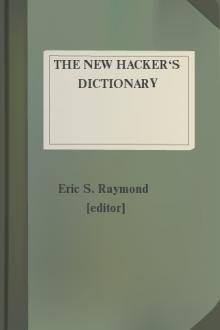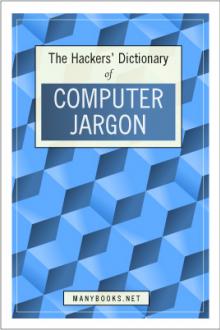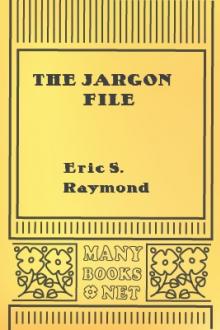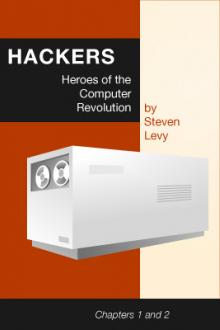The New Hacker's Dictionary by Eric S. Raymond (romantic novels to read .txt) 📕

- Author: Eric S. Raymond
- Performer: 0262680920
Book online «The New Hacker's Dictionary by Eric S. Raymond (romantic novels to read .txt) 📕». Author Eric S. Raymond
[125]BNF). Examples like the following are common:
So this walks into a bar one day...
There is also an accepted convention for `writing under erasure'; the
text
Be nice to this fool^H^H^H^Hgentleman,
he's visiting from corporate HQ.
reads roughly as "Be nice to this fool, er, gentleman...", with irony
emphasized. The digraph ^H is often used as a print representation for
a backspace, and was actually very visible on old-style printing
terminals. As the text was being composed the characters would be
echoed and printed immediately, and when a correction was made the
backspace keystrokes would be echoed with the string '^H'. Of course,
the final composed text would have no trace of the backspace
characters (or the original erroneous text).
This convention parallels (and may have been influenced by) the ironic
use of `slashouts' in science-fiction fanzines.
A related habit uses editor commands to signify corrections to
previous text. This custom faded in email as more mailers got good
editing capabilities, only to tale on new life on IRCs and other
line-based chat systems.
I've seen that term used on alt.foobar often.
Send it to Erik for the File.
Oops...s/Erik/Eric/.
The s/Erik/Eric/ says "change Erik to Eric in the preceding". This
syntax is borrowed from the Unix editing tools ed and sed, but is
widely recognized by non-Unix hackers as well.
In a formula, * signifies multiplication but two asterisks in a row
are a shorthand for exponentiation (this derives from FORTRAN). Thus,
one might write 2 ** 8 = 256.
Another notation for exponentiation one sees more frequently uses the
caret (^, ASCII 1011110); one might write instead 2^8 = 256. This goes
all the way back to Algol-60, which used the archaic ASCII `up-arrow'
that later became the caret; this was picked up by Kemeny and Kurtz's
original BASIC, which in turn influenced the design of the bc(1) and
dc(1) Unix tools, which have probably done most to reinforce the
convention on Usenet. (TeX math mode also uses ^ for exponention.) The
notation is mildly confusing to C programmers, because ^ means bitwise
exclusive-or in C. Despite this, it was favored 3:1 over ** in a
late-1990 snapshot of Usenet. It is used consistently in this lexicon.
In on-line exchanges, hackers tend to use decimal forms or improper
fractions (3.5' or7/2') rather than `typewriter style' mixed
fractions (`3-1/2'). The major motive here is probably that the former
are more readable in a monospaced font, together with a desire to
avoid the risk that the latter might be read as `three minus
one-half'. The decimal form is definitely preferred for fractions with
a terminating decimal representation; there may be some cultural
influence here from the high status of scientific notation.
Another on-line convention, used especially for very large or very
small numbers, is taken from C (which derived it from FORTRAN). This
is a form of scientific notation' usinge' to replace `*10^'; for
example, one year is about 3e7 seconds long.
The tilde (~) is commonly used in a quantifying sense of
approximately'; that is, ~50 meansabout fifty'.
On Usenet and in the [126]MUD world, common C boolean, logical, and
relational operators such as |, &, ||, &&, !, ==, !=, >, <, >=, and =<
are often combined with English. The Pascal not-equals, <>, is also
recognized, and occasionally one sees /= for not-equals (from Ada,
Common Lisp, and Fortran 90). The use of prefix `!' as a loose synonym
for not-' orno-' is particularly common; thus, `!clue' is read
no-clue' orclueless'.
A related practice borrows syntax from preferred programming languages
to express ideas in a natural-language text. For example, one might
see the following:
In jrh578689@thudpucker.com J. R. Hacker wrote:
I recently had occasion to field-test the Snafu
Systems 2300E adaptive gonkulator. The price was
right, and the racing stripe on the case looked
kind of neat, but its performance left something
to be desired.
Yeah, I tried one out too.
ifdef FLAMEHasn't anyone told those idiots that you can't get
decent bogon suppression with AFJ filters at today's
net volumes?
endif / FLAME /I guess they figured the price premium for true
frame-based semantic analysis was too high.
Unfortunately, it's also the only workable approach.
I wouldn't recommend purchase of this product unless
you're on a very tight budget.
include--
== Frank Foonly (Fubarco Systems)In the above, the #ifdef/#endif pair is a conditional compilation
syntax from C; here, it implies that the text between (which is a
[127]flame) should be evaluated only if you have turned on (or defined
on) the switch FLAME. The #include at the end is C for "include
standard disclaimer here"; the `standard disclaimer' is understood to
read, roughly, "These are my personal opinions and not to be construed
as the official position of my employer."
The top section in the example, with > at the left margin, is an
example of an inclusion convention we'll discuss below.
More recently, following on the huge popularity of the World Wide Web,
pseudo-HTML markup has become popular for similar purposes:
Your father was a hamster and your mother smelt of elderberries!
You'll even see this with an HTML-style modifier:
You seem well-suited for a career in government.
Another recent (late 1990s) construction now common on USENET seems to
be borrowed from Perl. It consists of using a dollar sign before an
uppercased form of a word or acronym to suggest any [128]random member
of the class indicated by the word. Thus: `$PHB' means "any random
member of the class `Pointy-Haired Boss'".
Hackers also mix letters and numbers more freely than in mainstream
usage. In particular, it is good hackish style to write a digit
sequence where you intend the reader to understand the text string
that names that number in English. So, hackers prefer to write `1970s'
rather than nineteen-seventies' or1970's' (the latter looks like a
possessive).
It should also be noted that hackers exhibit much less reluctance to
use multiply-nested parentheses than is normal in English. Part of
this is almost certainly due to influence from LISP (which uses deeply
nested parentheses (like this (see?)) in its syntax a lot), but it has
also been suggested that a more basic hacker trait of enjoying playing
with complexity and pushing systems to their limits is in operation.
Finally, it is worth mentioning that many studies of on-line
communication have shown that electronic links have a de-inhibiting
effect on people. Deprived of the body-language cues through which
emotional state is expressed, people tend to forget everything about
other parties except what is presented over that ASCII link. This has
both good and bad effects. A good one is that it encourages honesty
and tends to break down hierarchical authority relationships; a bad
one is that it may encourage depersonalization and gratuitous
rudeness. Perhaps in response to this, experienced netters often
display a sort of conscious formal politesse in their writing that has
passed out of fashion in other spoken and written media (for example,
the phrase "Well said, sir!" is not uncommon).
Many introverted hackers who are next to inarticulate in person
communicate with considerable fluency over the net, perhaps precisely
because they can forget on an unconscious level that they are dealing
with people and thus don't feel stressed and anxious as they would
face to face.
Though it is considered gauche to publicly criticize posters for poor
spelling or grammar, the network places a premium on literacy and
clarity of expression. It may well be that future historians of
literature will see in it a revival of the great tradition of personal
letters as art.
Node:Email Quotes, Next:[129]Hacker Speech Style, Previous:[130]Hacker
Writing Style, Up:[131]Top
Email Quotes and Inclusion Conventions
One area where conventions for on-line writing are still in some flux
is the marking of included material from earlier messages -- what
would be called `block quotations' in ordinary English. From the usual
typographic convention employed for these (smaller font at an extra
indent), there derived a practice of included text being indented by
one ASCII TAB (0001001) character, which under Unix and many other
environments gives the appearance of an 8-space indent.
Early mail and netnews readers had no facility for including messages
this way, so people had to paste in copy manually. BSD Mail(1) was the
first message agent to support inclusion, and early Usenetters
emulated its style. But the TAB character tended to push included text
too far to the right (especially in multiply nested inclusions),
leading to ugly wraparounds. After a brief period of confusion (during
which an inclusion leader consisting of three or four spaces became
established in EMACS and a few mailers), the use of leading > or >
became standard, perhaps owing to its use in ed(1) to display tabs
(alternatively, it may derive from the > that some early Unix mailers
used to quote lines starting with "From" in text, so they wouldn't
look like the beginnings of new message headers). Inclusions within
inclusions keep their > leaders, so the `nesting level' of a quotation
is visually apparent.
The practice of including text from the parent article when posting a
followup helped solve what had been a major nuisance on Usenet: the
fact that articles do not arrive at different sites in the same order.
Careless posters used to post articles that would begin with, or even
consist entirely of, "No, that's wrong" or "I agree" or the like. It
was hard to see who was responding to what. Consequently, around 1984,
new news-posting software evolved a facility to automatically include
the text of a previous article, marked with "> " or whatever the
poster chose. The poster was expected to delete all but the relevant
lines. The result has been that, now, careless posters post articles
containing the entire text of a preceding article, followed only by
"No, that's wrong" or "I agree".
Many people feel that this cure is worse than the original disease,
and there soon appeared newsreader software designed to let the reader
skip over included text if desired. Today, some posting software
rejects articles containing too high a proportion of lines beginning
with `>' -- but this too has led to undesirable workarounds, such as
the deliberate inclusion of zero-content filler lines which aren't
quoted and thus pull the message below the rejection threshold.
Because the default mailers supplied with Unix and other operating
systems haven't evolved as quickly as human usage, the older
conventions using a leading TAB or three or four spaces are still
alive; however, >-inclusion is now clearly the prevalent form in both
netnews and mail.
Inclusion practice is still evolving, and disputes over the `correct'
inclusion style occasionally lead to [132]holy wars.
Most netters view an inclusion as a promise that comment on it will
immediately follow. The preferred, conversational style looks like
this,
relevant excerpt 1
response to excerpt
relevant excerpt 2
response to excerpt
relevant excerpt 3
response to excerpt
or for short messages like this:
entire message
response to message
Thanks to poor design of some PC-based mail agents, one will
occasionally see the entire quoted message after the response, like
this
response to message
entire message
but this practice is strongly deprecated.
Though > remains the standard inclusion leader, | is occasionally used
for extended quotations where original variations in indentation are
being retained (one mailer even combines these and uses |>). One also
sees different styles of quoting a number of authors in the same
message: one (deprecated because it loses information) uses a leader
of > for everyone, another (the most common) is > > > > , > > > ,
etc. (or >>>> , >>>, etc., depending on line length and nesting depth)
reflecting the original





Comments (0)